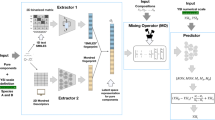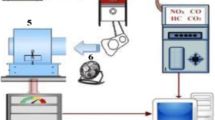Abstract
Fuel design is a complex multi-objective optimization problem in which facile and robust methods are urgently demanded. Herein, a complete workflow for designing a fuel blending scheme is presented, which is theoretically supported, efficient, and reliable. Based on the data distribution of the composition and properties of the blending fuels, a model of polynomial regression with appropriate hypothesis space was established. The parameters of the model were further optimized by different intelligence algorithms to achieve high-precision regression. Then, the design of a blending fuel was described as a multi-objective optimization problem, which was solved using a Nelder–Mead algorithm based on the concept of Pareto domination. Finally, the design of a target fuel was fully validated by experiments. This study provides new avenues for designing various blending fuels to meet the needs of next-generation engines.














Similar content being viewed by others
References
Emami-Taba L, Irfan MF, Wan Daud WMA et al (2013) Fuel blending effects on the co-gasification of coal and biomass—a review. Biomass Bioenergy 57:249–263
Arias B, Pevida C, Rubiera F et al (2008) Effect of biomass blending on coal ignition and burnout during oxy-fuel combustion. Fuel 87(12):2753–2759
Liu Y, Yang Z, Yu Z et al (2023) Generative artificial intelligence and its applications in materials science: current situation and future perspectives. J Materiomics 9(4):798–816
Liu Y, Yang Z, Zou X et al (2023) Data quantity governance for machine learning in materials science. Natl Sci Rev 10(7):nwad125
Liu R, Liu R, Liu Y et al (2022) Design of fuel molecules based on variational autoencoder. Fuel 316:123426
Schütt KT, Arbabzadah F, Chmiela S et al (2017) Quantum-chemical insights from deep tensor neural networks. Nat Commun 8:13890
Kessler T, Sacia ER, Bell AT et al (2017) Artificial neural network based predictions of cetane number for furanic biofuel additives. Fuel 206:171–179
Li R, Herreros JM, Tsolakis A et al (2022) Integrated machine learning-quantitative structure property relationship (ML-QSPR) and chemical kinetics for high throughput fuel screening toward internal combustion engine. Fuel 307:121908
Li R, Herreros JM, Tsolakis A et al (2022) Machine learning and deep learning enabled fuel sooting tendency prediction from molecular structure. J Mol Graph Model 111:108083
Cengiz E, Babagiray M, Emre Aysal F et al (2022) Kinematic viscosity estimation of fuel oil with comparison of machine learning methods. Fuel 316:123422
Gilmer J, Schoenholz SS, Riley PF et al (2017) Neural message passing for quantum chemistry. In: Proceedings of the 34th international conference on machine learning, Sydney, Australia, vol 70, pp 1263–1272
Schweidtmann AM, Rittig JG, König A et al (2020) Graph neural networks for prediction of fuel ignition quality. Energy Fuels 34(9):11395–11407
Yaka H, Insel MA, Yucel O et al (2022) A comparison of machine learning algorithms for estimation of higher heating values of biomass and fossil fuels from ultimate analysis. Fuel 320:123971
Shi Y (2021) Support vector regression-based QSAR models for prediction of antioxidant activity of phenolic compounds. Sci Rep 11(1):8806
Najafi G, Ghobadian B, Moosavian A et al (2016) SVM and ANFIS for prediction of performance and exhaust emissions of a SI engine with gasoline–ethanol blended fuels. Appl Therm Eng 95:186–203
Ji Y, Yang H, Liu Z, Bi Q (2021) Endothermic performance and mechanism of aviation kerosene HD-01 cracking by titanate coupling agents. Acta Petrol Sin 37:1114–1119
Liu Y, Zhang H, Pan L et al (2022) High-energy-density gelled fuels with high stability and shear thinning performance. Chin J Chem Eng 43:99–109
Deng Q, Zhang X, Wang L et al (2015) Catalytic isomerization and oligomerization of endo-dicyclopentadiene using alkali-treated hierarchical porous HZSM-5. Chem Eng Sci 135:540–546
Li Y, Zou JJ, Zhang X et al (2010) Product distribution of tricyclopentadiene from cycloaddition of dicyclopentadiene and cyclopentadiene: a theoretical and experimental study. Fuel 89(9):2522–2527
Zieliński A, Marset X, Golz C et al (2020) Two-step synthesis of heptacyclo[6.6.0.02, 6.03, 13.04, 11.05, 9.010, 14]tetradecane from norbornadiene: mechanism of the cage assembly and post-synthetic functionalization. Angew Chem Int Ed Engl 59(51):23299–23305
Li C, Zhang C, Liu R et al (2022) Heterogeneously supported active Pd(0) complex on silica mediated by PEG as efficient dimerization catalyst for the production of high energy density fuel. Mol Catal 520:112170
Rupakheti C, Virshup A, Yang W et al (2015) Strategy to discover diverse optimal molecules in the small molecule universe. J Chem Inf Model 55(3):529–537
Kanal IY, Owens SG, Bechtel JS et al (2013) Efficient computational screening of organic polymer photovoltaics. J Phys Chem Lett 4(10):1613–1623
Kwon Y, Lee J (2021) MolFinder: an evolutionary algorithm for the global optimization of molecular properties and the extensive exploration of chemical space using SMILES. J Cheminform 13(1):24
Olsson DM, Nelson LS (1975) The Nelder-Mead simplex procedure for function minimization. Technometrics 17(1):45–51
Luersen MA, Le Riche R (2004) Globalized Nelder-Mead method for engineering optimization. Comput Struct 82(23–26):2251–2260
Wang D, Tan D, Liu L (2018) Particle swarm optimization algorithm: an overview. Soft Comput A Fusion Found Methodol Appl 22(2):387–408
Jiang Y, Hu T, Huang C et al (2007) An improved particle swarm optimization algorithm. Appl Math Comput 193(1):231–239
Voorneveld M (2003) Characterization of Pareto dominance. Oper Res Lett 31(1):7–11
Asrari A, Lotfifard S, Payam MS (2016) Pareto dominance-based multiobjective optimization method for distribution network reconfiguration. IEEE Trans Smart Grid 7(3):1401–1410
Audet C, Hare W (2017) Derivative-free and blackbox optimization. Springer, Cham
Gunantara N (2018) A review of multi-objective optimization: methods and its applications. Cogent Eng 5(1):1502242
Deb K, Deb K (2014) Multi-objective optimization. In: Burke EK, Kendall G (eds) Search methodologies: introductory tutorials in optimization and decision support techniques. Springer, Boston, pp 403–449
Acknowledgements
The authors appreciate the support from the National Key R&D Program of China (No. 2021YFC2103701), the National Natural Science Foundation of China (No. 22178248) and the Haihe Laboratory of Sustainable Chemical Transformations.
Author information
Authors and Affiliations
Corresponding author
Ethics declarations
Conflict of interest
All authors declare that there are no competing interests.
Supplementary Information
Below is the link to the electronic supplementary material.
Rights and permissions
Springer Nature or its licensor (e.g. a society or other partner) holds exclusive rights to this article under a publishing agreement with the author(s) or other rightsholder(s); author self-archiving of the accepted manuscript version of this article is solely governed by the terms of such publishing agreement and applicable law.
About this article
Cite this article
Liu, R., Li, C., Wang, L. et al. Multi-objective Design of Blending Fuel by Intelligent Optimization Algorithms. Trans. Tianjin Univ. (2024). https://doi.org/10.1007/s12209-024-00393-2
Received:
Revised:
Accepted:
Published:
DOI: https://doi.org/10.1007/s12209-024-00393-2




